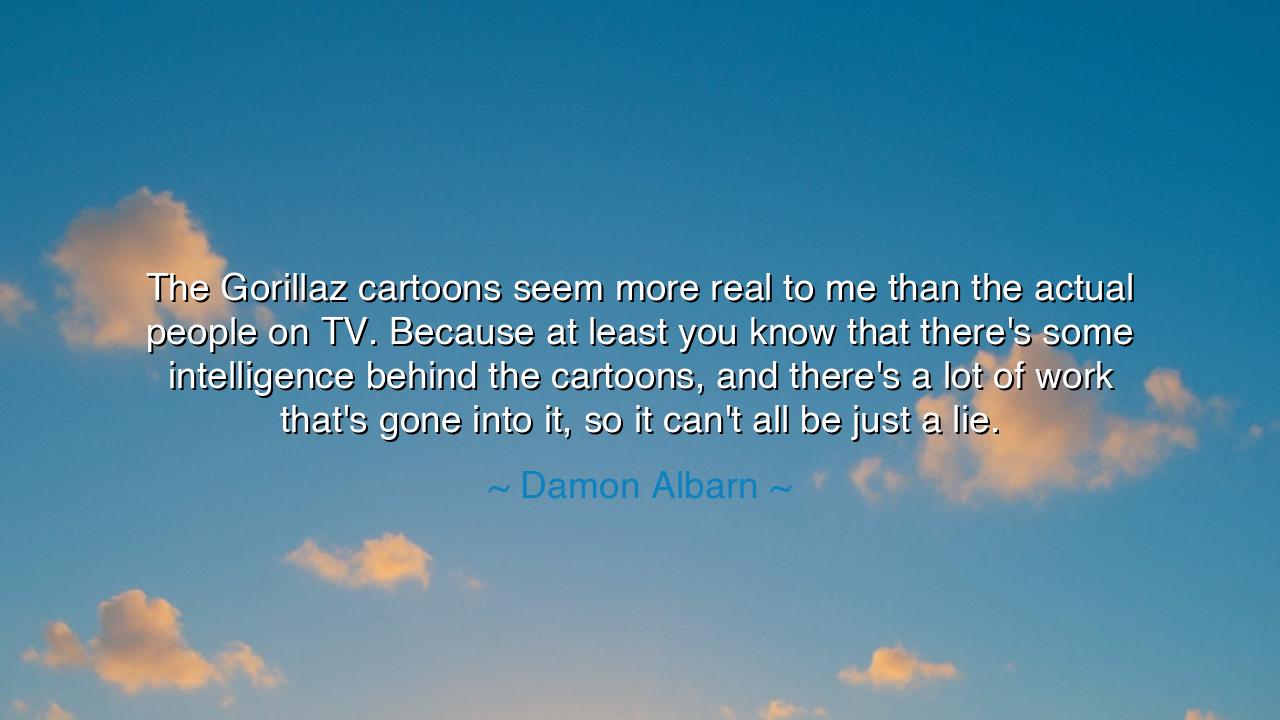
The Gorillaz cartoons seem more real to me than the actual people
The Gorillaz cartoons seem more real to me than the actual people on TV. Because at least you know that there's some intelligence behind the cartoons, and there's a lot of work that's gone into it, so it can't all be just a lie.






When Damon Albarn declared, “The Gorillaz cartoons seem more real to me than the actual people on TV. Because at least you know that there’s some intelligence behind the cartoons, and there’s a lot of work that’s gone into it, so it can’t all be just a lie,” he spoke not only as a musician, but as a philosopher of modern illusion. His words pierce through the glittering veil of the media age, where image often outweighs truth, and spectacle masquerades as authenticity. In this age of endless screens and fleeting fame, Albarn reminds us that reality is not what is most visible, but what is most crafted with care, intelligence, and sincerity. His creation, the virtual band Gorillaz, was itself a rebellion against the hollow showmanship of celebrity culture — a way to restore meaning through imagination.
In his time, as in ours, the world of television and fame had become a mirror that no longer reflected the soul, but only the mask. “Actual people on TV,” as Albarn laments, often play parts scripted not by truth but by commerce — images shaped to sell, not to speak. Their smiles are rehearsed, their conflicts manufactured, their intimacy designed for profit. Yet in cartoon figures — hand-drawn, digital, and unreal — he found something strangely more human. For behind them stood intention, intellect, and artistry. The cartoons did not pretend to be real, and so, paradoxically, they became more real — for they made no false claim to authenticity. They were fiction that told the truth, while the living faces on screens were truth turned into fiction.
There is an ancient echo in this idea. The Greek philosopher Plato, in his allegory of the cave, warned that most people mistake shadows for reality — that they live chained before flickering images, never turning to see the fire that casts them. Albarn’s words awaken that same warning for the digital age. Our televisions, our devices, our endless feeds — these are the walls of a new cave. We watch faces that seem alive, but their light is hollow; we consume stories that seem real, but their purpose is to keep us docile. Yet the artist, like the philosopher, creates images not to deceive but to reveal. The Gorillaz — unreal in form — become truer than reality, for they are crafted in honesty, and their purpose is not to manipulate, but to provoke thought.
Consider the creation of Gorillaz itself. Albarn and the artist Jamie Hewlett built a virtual band whose members — 2D, Murdoc, Noodle, and Russel — existed only in animation. Yet their music carried emotion, complexity, and social commentary deeper than most of what the mainstream offered. The world could not see the musicians’ faces, but they could feel their souls. In this inversion lies a profound truth: when the mask is made with awareness, it can reveal more than the naked face. When art acknowledges its artifice, it frees itself from deceit. Thus, Albarn’s “cartoons” became vessels for truth, while the “real people on TV” became vessels for illusion.
His insight carries a warning for the modern soul: beware of what calls itself real without earning it. For reality in itself means little — it is sincerity that makes a thing true. A sculpture is not a living man, yet it can express more humanity than many who breathe. A song is not flesh, yet it can pierce deeper than a thousand speeches. What Albarn teaches is that truth is born not from mere existence, but from effort, intelligence, and authenticity. That which is made with care and understanding, even if fictional, holds more life than what is careless and empty.
And so, children of the future, take this lesson into your own craft and living: do not mistake visibility for value, nor fame for depth. Seek meaning, not applause. Let your words, your art, your choices carry the weight of thought, the grace of intention. For in a world flooded with noise, the voice that endures is the one spoken from the soul. Whether you build songs or cities, books or dreams — build them with intelligence, and let truth dwell within their walls.
Finally, remember this: we live in an age of masks, but it is not the mask that deceives — it is the emptiness behind it. When you create, live, or speak, ensure that behind your image stands substance, and behind your actions, truth. As Albarn found in his cartoon band, the unreal can become immortal when it serves a genuine heart. The Gorillaz may be drawings, but they are drawn from the spirit. And in a time when so much of reality is a lie, it is the dreamer, not the celebrity, who keeps the human story alive.






AAdministratorAdministrator
Welcome, honored guests. Please leave a comment, we will respond soon